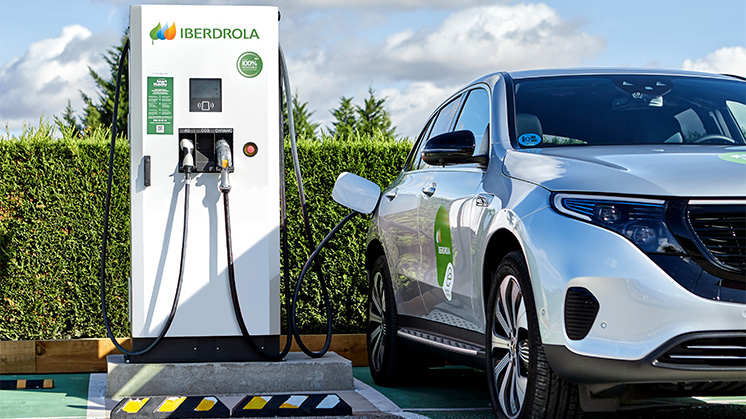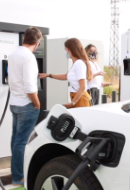Electric mobility
What is electric mobility?
Sustainable mobility Electric mobility
In a world evolving towards innovation and sustainability, electric mobility has become a solution that not only redefines the way we get around, but also plays a crucial role in reducing carbon emissions and building more sustainable communities. Discover what electric mobility is, its history, its contribution to the energy transition, how it works and much more.

The decarbonisation of the economy and the energy transition are an unimaginable scenario if we do not introduce relevant changes in the way we move. According to the International Energy Agency, the transport sector generates more than one third of the world's greenhouse gas (GHG) emissions.
As the effects of climate change become more evident and environmental awareness takes root socially, governments, businesses and individuals are joining forces to embrace sustainable mobility that does not compromise air quality or deplete natural resources. The electrification of transport represents a revolutionary change and is redefining our relationship with vehicles.
Electric mobility, what is it?
Electric mobility is a term that refers to the use of vehicles that use electricity to power all or part of their engine, providing a more sustainable alternative to fossil fuels such as petrol or diesel. There are two main types of electric mobility: pure electric and hybrid.
Today, this type of mobility offers solutions for a wide variety of journeys: from short-distance trips with small loads (for bicycles and electric motorbikes) to long journeys with heavy loads (with public transport vehicles and electric trucks). All in all, electric mobility has become the mobility promise of the future.
How does an electric vehicle (EV) work?
An electric vehicle operates differently from an internal combustion vehicle in that it uses electricity instead of fossil fuels to generate motion. At its heart is a rechargeable battery that stores energy in chemical form. When the vehicle is connected to a source or charging point, the battery stores that energy.
An inverter then converts the direct current (DC) from the battery into alternating current (AC) and sends it to an electric motor. This critical part of the vehicle generates motion by converting electrical energy into mechanical energy, driving the wheels of the car.
Thus, when the driver presses the accelerator pedal, a quantity of electrical energy reaches the motor; while, when the user lifts his or her foot off the accelerator or steps on the brake, the electric motor can act as a generator and convert some of the vehicle's kinetic energy into electricity, a regenerated energy that is sent back to the battery to increase the vehicle's efficiency and range.
This electrification of mobility, which allows independence from polluting fuels, offers several advantages compared to conventional vehicles.
Advantages of electric vehicles
There are more and more electric car models, more manufacturers and more economical models. This boom is due to the wide-ranging advantages offered by electric cars, such as fuel savings and the elimination of CO2 emissions. In addition, these cars reduce costs by not relying on limited fossil fuels and by reducing the maintenance required to run them. They are quiet, comfortable and there is a growing range of economic and tax incentives for their purchase compared to internal combustion cars.

Electric car batteries
Everything you need to know about electric car batteries.

History of the electric car
Electrically powered cars have been on the road for almost two centuries.

Infraestructure for electric mobility
Are our roads ready for the electric vehicle revolution?
Types of electric vehicles
There are two types of electric vehicles: all-electric cars, which only run on battery power, and hybrid cars, which operate on electric charge and fuel. Within this classification, there are different types of cars:
Battery Electric Vehicles (BEV)
These models are entirely powered by electricity. In order to charge the car's battery, as with any electric device, it needs to be connected to a charging point. They have large-capacity batteries that store electrical energy and power electric motors to generate motion.
Hydrogen Fuel Cell Electric Vehicles (FCEV)
These vehicles are powered by renewable energy sources, but do not run on batteries, but on hydrogen fuel cells. Unlike conventional electric cars, which have a battery that stores energy, FCEVs have a fuel cell that produces energy when needed. This unit, which is usually a hydrogen fuel cell, generates the electricity that drives the vehicle through electrolysis, a chemical reaction between hydrogen and oxygen.
Extended-range electric vehicle (EVER)
This type of car combines elements of the electric vehicle (EV) and the plug-in hybrid vehicle. Although propulsion power is provided almost entirely by an electric drive unit, they are equipped with a small internal combustion engine to generate additional power if needed. EVERs provide the efficiency and reduced emissions of an electric vehicle while overcoming the range limitations of using a combustion engine as a backup.
Plug-in Hybrid Vehicle (PHEV)
Plug-in hybrid vehicles combine an internal combustion engine with an electric motor and a battery, which can be recharged from an external power source or charging point. The main characteristic of these models is that they can operate both in electric mode, using only the energy stored in the battery, and in hybrid format, combining the power of the internal combustion engine with electric power.
Hybrid Electric Vehicle (HEV)
This type of vehicle combines at least two energy sources for propulsion. In general, they have a conventional internal combustion engine (usually petrol or diesel) with an electric motor. Non-plug-in hybrid vehicles cannot obtain energy from a charging point, but produce it by their own means when braking. The electric motor assists the internal combustion engine at times of high demand. They are perhaps the most widespread today as their mechanical schemes are more or less simple and allow a more or less contained price.
Micro-hybrid cars (MHEV)
Micro-hybrids are thermal vehicles to which a small electric assistance system is added to recover energy, but which is made up of a small 48V battery. This energy is used either to back up the internal combustion engine during acceleration or to supply the electrical consumption of certain systems in order to reduce the acceleration of the internal combustion engine.
History of the electric car
The electric vehicle is considered the car of the future because of its technology, environmental friendliness and economic and technical advantages. However, its emergence is far from new. The history of the electric car goes back almost two centuries, predating petrol cars.
The first electric car
The creation of the electric vehicle was the result of a combination of innovative developments and technical improvements. In 1828, Hungarian inventor and engineer Ányos Jedlik created the centrepiece of all electric machines: the world's first electric motor, which he later applied to a small model car. In turn, the American blacksmith Thomas Davenport built a similar device that ran on an electrified circular track. The key moment came between 1832 and 1839, when the Scottish entrepreneur and chemist Robert Anderson developed and presented a prototype that provided an evolution of a traditional carriage by moving thanks to the energy supplied by electric cells. This is considered the first electric carriage.
With the development of new models in later years and the emergence of the rechargeable battery, the electric car became a hit in the early 20th century in cities, especially for the upper classes. Although after the First World War the fuel car began to gain ground, the presence of electric vehicles has resurged in recent years as a reaction to climate change and due to the multiple benefits of sustainable mobility.
Find out how electric mobility helps the energy transition
The fight against climate change is one of the most important challenges facing humanity in the 21st century and the decarbonisation of the economy is a task in which we must all be involved. To accelerate the shift towards a resilient and planet-friendly model, three main lines of action need to be undertaken:
![]() Renewable energy deployment.
Renewable energy deployment.
![]() Boosting technological innovation.
Boosting technological innovation.
![]() Electrification of the economy, transport and building.
Electrification of the economy, transport and building.
Electric mobility thus becomes an essential part of the transformation of the model. It is a clean technology that helps reduce emissions of polluting gases and improves air quality in cities, as electric vehicles do not emit carbon dioxide or other pollutants. An even more positive effect if electric vehicles are powered by renewable energy sources.
Transport is the main sector of energy consumption and the main emitter of greenhouse gases in the world, so action on transport is both important and urgent. Moreover, mobility is not the same everywhere and depends on different factors such as the size of a city or its population density. Accelerating the transition to sustainable, electric mobility that is appropriate to the surrounding circumstances is the great challenge of today.





